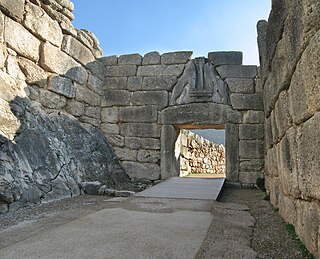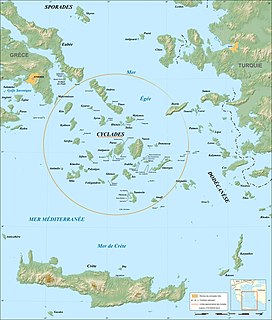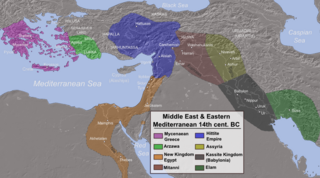
Aegean civilization is a general term for the Bronze Age civilizations of Greece around the Aegean Sea. There are three distinct but communicating and interacting geographic regions covered by this term: Crete, the Cyclades and the Greek mainland. Crete is associated with the Minoan civilization from the Early Bronze Age. The Cyclades converge with the mainland during the Early Helladic ("Minyan") period and with Crete in the Middle Minoan period. From ca. 1450 BC, the Greek Mycenaean civilization spreads to Crete.

The 2nd millennium BC spanned the years 2000 through 1001 BC. In the Ancient Near East, it marks the transition from the Middle to the Late Bronze Age. The Ancient Near Eastern cultures are well within the historical era: The first half of the millennium is dominated by the Middle Kingdom of Egypt and Babylonia. The alphabet develops. At the center of the millennium, a new order emerges with Minoan Greek dominance of the Aegean and the rise of the Hittite Empire. The end of the millennium sees the Bronze Age collapse and the transition to the Iron Age.

Mycenae is an archaeological site near Mykines in Argolis, north-eastern Peloponnese, Greece. It is located about 120 kilometres south-west of Athens; 11 kilometres north of Argos; and 48 kilometres south of Corinth. The site is 19 kilometres inland from the Saronic Gulf and built upon a hill rising 900 feet above sea level.

Kültepe, also known as Kanesh or Nesha, is an archaeological site in Kayseri Province, Turkey. The nearest modern city to Kültepe is Kayseri, about 20 km southwest. It consists of a tell, the actual Kültepe, and a lower town, where an Assyrian settlement was found. Its ancient names are recorded in Assyrian and Hittite sources. In Old Assyrian inscriptions from the 20th and the 19th century BCE, the city was mentioned as Kaneš (Kanesh); in later Hittite inscriptions, the city was mentioned as Neša, or occasionally as Aniša (Anisha). In 2014, the archaeological site was inscribed in the Tentative list of World Heritage Sites in Turkey. It is also the site of discovery of the earliest traces of the Hittite language, the earliest attestation of any Indo-European language, dated to the 20th century BCE.

The Minoan civilization was a Bronze Age Aegean civilization on the island of Crete and other Aegean Islands, flourishing from c. 3000 BC to c. 1450 BC and, after a late period of decline, finally ending around 1100 BC. It represents the first advanced civilization in Europe, leaving behind massive building complexes, tools, artwork, writing systems, and a massive network of trade. The civilization was rediscovered at the beginning of the 20th century through the work of British archaeologist Sir Arthur Evans. The name "Minoan" derives from the mythical King Minos and was coined by Evans, who identified the site at Knossos with the labyrinth and the Minotaur. The Minoan civilization has been described as the earliest of its kind in Europe, and historian Will Durant called the Minoans "the first link in the European chain".
According to Greek mythology and legendary prehistory of the Aegean region, the Minyans or Minyae were an autochthonous group inhabiting the Aegean region. However, the extent to which the prehistory of the Aegean world is reflected in literary accounts of legendary peoples, and the degree to which material culture can be securely linked to language-based ethnicity have been subjected to repeated revision.

Tiryns or is a Mycenaean archaeological site in Argolis in the Peloponnese, and the location from which mythical hero Heracles performed his Twelve Labours.

The Carians were the ancient inhabitants of Caria in southwest Anatolia.

Cycladic culture was a Bronze Age culture found throughout the islands of the Cyclades in the Aegean Sea. In chronological terms, it is a relative dating system for artefacts which broadly complements Helladic chronology and Minoan chronology (Crete) during the same period of time.

The history of Greece encompasses the history of the territory of the modern nation-state of Greece as well as that of the Greek people and the areas they inhabited and ruled historically. The scope of Greek habitation and rule has varied throughout the ages and as a result, the history of Greece is similarly elastic in what it includes. Generally, the history of Greece is divided into the following periods:

Mycenaean Greece was the last phase of the Bronze Age in Ancient Greece, spanning the period from approximately 1600–1100 BC. It represents the first advanced and distinctively Greek civilization in mainland Greece with its palatial states, urban organization, works of art, and writing system. The most prominent site was Mycenae, in the Argolid, after which the culture of this era is named. Other centers of power that emerged included Pylos, Tiryns, Midea in the Peloponnese, Orchomenos, Thebes, Athens in Central Greece and Iolcos in Thessaly. Mycenaean and Mycenaean-influenced settlements also appeared in Epirus, Macedonia, on islands in the Aegean Sea, on the coast of Asia Minor, the Levant, Cyprus, and Italy.

In classical Greece, Lerna was a region of springs and a former lake near the east coast of the Peloponnesus, south of Argos. Even though much of the area is marshy, Lerna is located on a geographically narrow point between mountains and the sea, along an ancient route from the Argolid to the southern Peloponnese; this location could have potentially resulted in the importance of the settlement.

Helladic chronology is a relative dating system used in archaeology and art history. It complements the Minoan chronology scheme devised by Sir Arthur Evans for the categorisation of Bronze Age artefacts from the Minoan civilization within a historical framework. Whereas Minoan chronology is specific to Crete, the cultural and geographical scope of Helladic chronology is mainland Greece during the same timespan (c.3200–c.1050). Similarly, a Cycladic chronology system is used for artifacts found in the Aegean islands. Archaeological evidence has shown that, broadly, civilisation developed concurrently across the whole region and so the three schemes complement each other chronologically. They are grouped together as "Aegean" in terms such as Aegean art and, rather more controversially, Aegean civilization.

The megaron, plural megara, was the great hall in ancient Greek palace complexes. Architecturally, it was a rectangular hall that was surrounded by four columns, fronted by an open, two-columned portico, and had a central, open hearth that vented though an oculus in the roof. The megaron also contained the throne-room of the wanax, or Mycenaean ruler, whose throne was located in the main room with the central hearth. Similar architecture is found in the Ancient Near East though the presence of the open portico, generally supported by columns, is particular to the Aegean. Megara are sometimes referred to as "long-rooms", as defined by their rectangular (non-square) shape and the position of their entrances, which are always along the shorter wall so that the depth of the space is larger than the width. There were often many rooms around the central megaron, such as archive rooms, offices, oil-press rooms, workshops, potteries, shrines, corridors, armories, and storerooms for such goods as wine, oil and wheat.

The Late Bronze Age collapse was a transition period in the Near East, Anatolia, the Aegean region, North Africa, the Caucasus, the Balkans and the Eastern Mediterranean which took place from the Late Bronze Age to the Early Iron Age. It was a transition which historians believe was violent, sudden, and culturally disruptive. The palace economy of the Aegean region and Anatolia that characterized the Late Bronze Age disintegrated, transforming into the small isolated village cultures of the Greek Dark Ages.
The Pre-Greek substrate consists of the unknown language(s) spoken in prehistoric Greece before the coming of the Proto-Greek language in the area during the Bronze Age. It is possible that Greek acquired some thousand words and proper names from such a language(s), because some of its vocabulary cannot be satisfactorily explained as deriving from Proto-Greek and a Proto-Indo-European reconstruction is almost impossible for such terms.

Minyan ware is a broad archaeological term describing varieties of a particular style of Aegean burnished pottery associated with the Middle Helladic period. The term was coined in the 19th century by German archaeologist Heinrich Schliemann after discovering the pottery in Orchomenos, Greece. Excavations conducted during the 1960s confirmed that Minyan ware evolved from the burnished pottery developed by the Tiryns culture of the Early Helladic III period.

Mycenaean pottery is an assemblage of terra cotta ceramics and ceramic styles originated, manufactured, or heavily used by the civilization termed Mycenaean in Greek history and prehistory. "Mycenaean" is a culture name rather than an archaeological one. It was originally a neologism of Heinrich Schliemann, a 19th-century archaeologist, who excavated at Mycenae, a geographic location in the northeast Peloponnesus. Believing in the factuality of the first known work of European literature, the Iliad, Schliemann assigned the geographic and cultural names of that work to his archaeological findings. The citadel at Mycenae thus became the capital and seat of the high king of the Achaeans, Agamemnon, who predominated over all the other kings of Hellas, or Greece. The language of the culture was not known at the time. Prophetically, he predicted that it would be Greek, which was finally substantiated long after his death.

The prehistory of Anatolia stretches from the Paleolithic era through to the appearance of classical civilisation in the middle of the 1st millennium BC. It is generally regarded as being divided into three ages reflecting the dominant materials used for the making of domestic implements and weapons: Stone Age, Bronze Age and Iron Age. The term Copper Age (Chalcolithic) is used to denote the period straddling the stone and Bronze Ages.

The military nature of Mycenaean Greece in the Late Bronze Age is evident by the numerous weapons unearthed, warrior and combat representations in contemporary art, as well as by the preserved Greek Linear B records. The Mycenaeans invested in the development of military infrastructure with military production and logistics being supervised directly from the palatial centres. This militaristic ethos inspired later Ancient Greek tradition, and especially Homer's epics, which are focused on the heroic nature of the Mycenaean-era warrior élite.
















